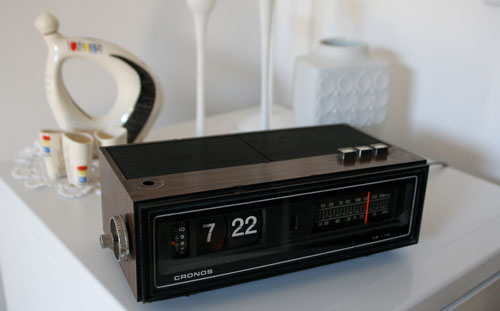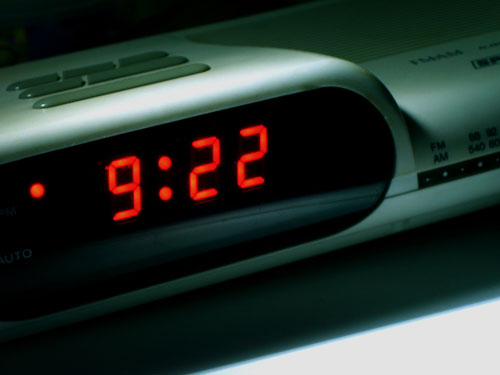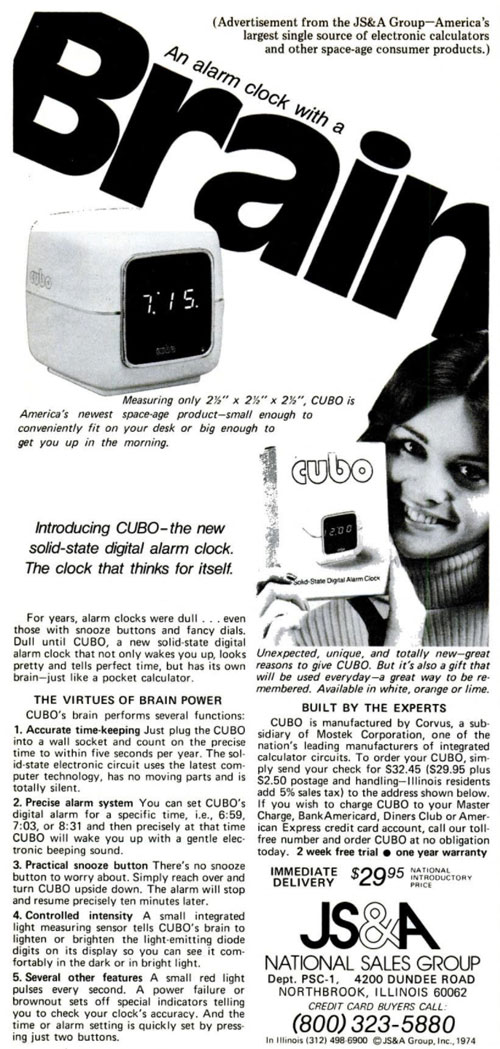The Worst Part Of Waking Up
As our alarms went from analog to digital, the noises they made became a lot more abrasive. Here's the story of the technology behind your alarm clock.
Today’s GIF is from Groundhog Day, Bill Murray’s best movie not directed by Wes Anderson. Lost in Translation is a close second.
Sponsored By … You?
If you find weird or unusual topics like this super-fascinating, the best way to tell us is to give us a nod on Ko-Fi. It helps ensure that we can keep this machine moving, support outside writers, and bring on the tools to support our writing. (Also it’s heartening when someone chips in.)
We accept advertising, too! Check out this page to learn more.
1831
The year that the Joseph Henry, the first secretary of the Smithsonian Institution, invented what’s widely considered the first electric doorbell, which used a tightly coiled electromagnet to create a ringing noise by forcing a magnet to swing at a bell using the electric current. A mechanical buzzer works in a similar fashion, except there’s no bell to hit and the buzz is caused by the movement of the magnet itself. This ScienceOnline video does a good job explaining how buzzers, which later found use in alarm clocks, did their things in the pre-digital era.

An example of a flip clock, the pathway between rotating hands and digital screens. (Anuj Biyani/Flickr)
The long road that got our alarm clocks beeping
The invention of the digital clock and the creation of those loud beeps and screeches you grew up on, are two slightly separate things. But what’s often interesting is the fact that most of the alarms you hear on a day to day basis tend to have a somewhat similar sound.
But that consistency didn’t come overnight (pun intended). In fact, alarm clocks evolved significantly over the years, generally following the basic model of noise reproduction that doorbells of the day did. As time could not be told with simply numbers in most cases, that meant most clocks had two hands of multiple sizes.
Still, innovation was definitely the name of the game for many clock makers, who offered plenty of competition.
Companies like Westclox, which produced the first alarm clocks with snooze functions, were helping alarm clocks to get past their hand-turning pasts. (Westclox is perhaps most famous for its Big Ben clocks, which make a quite-impressive alarm sound.)
Perhaps a key turning point for Westclox’s alarms, however, came from the Moonbeam, which was first released in 1948 and had a novel feature that’s fairly unique to this day—rather than simply going off with a loud buzzing noise, the alarm would initially try to wake you up with a bright flashing light that was hard to miss. After about 10 minutes or so, it would make a loud buzzing noise, as can be heard over this way. The clock, in an updated and reproduced form, is still sold today.
Meanwhile, the company TWEMCO made a name for itself for creating the first fully automatic flip clocks, which were able to not only offer up the time but also the day of the week and the month.
With the development of the transistor in the late 1940s, alarm clocks eventually did gain a digital component—along with a new friend. The innovation meant radios and clocks would become intertwined.
And as a result of this development, transistor-based solid-state alarm clocks started showing up in the 1960s, and while they did have alarms, they did not sound anything like the beeps and bloops we hear today. A coupleclips by YouTuber batterymaker highlight just how obnoxious these buzzes could really be. They certainly do the job, but in the context of the modern day, they feel, well … wrong.
Eventually, we’d find a little more consistency in or noises, and it’s something we can credit technology for.
“Among the benefits that might ultimately result from the development are: A thin television screen that can be hung on the living-room wall like a painting; electronic clocks and watches with no moving parts; [and] television screens and electronic signs whose images do not ‘wash out’ in bright outdoor light, as do displays now in use.”
— A 1968 New York Times article highlighting RCA’s announcement of the creation of the liquid crystal display or LCD, one of the most important technologies of the 20th century. (RCA, despite this head start, famously squandered its progress on this issue.) Part of this display featured what would be a major turning point in the creation of the alarm clock—a solid state clock with an LCD screen, which was officially patented in 1970 and quickly imitated by manufacturers around the world. The combination of LCD and light emitting diodes (LED) helped change the landscape for what alarm clocks could look like starting in the 1970s.

It’s the way the clock bleeds into your eye sockets. (Douglas Heriot/Flickr)
The evolution of the integrated circuit played an important role in making our alarms sound pretty similar
So, going back to the question I was posed, why the four beeps? And why are those beeps so common, and why is the single-blare alarm sound I know so common?
The evolution of the digital alarm clock is something of a combination of technologies that became ready at right around the same time—and the way they commoditized the product in general. First off, the buzzer of yore had shrunk to a very manageable size in the form of a piezoelectric transducer; and second, the innards of the alarm had become commoditized.
In regards to the first, a variety of inventions throughout the 1950s and 1960s took aim at the idea that electronic alarms weren’t reasonable enough in size or design, and that there were specific use cases in which the quality of the sound mattered less than the fact that it was jarring and effective. One such patent received by Bronson M. Potter in 1966 for the “electrically operated audible alarm,” makes this case pretty clear.
“In an alarm in accordance with the invention, the advantages of a peculiar effect can be realized, since good waveshape is of no particular interest; just the opposite, in general, the more ragged the wave shape the more arresting the tone, the transducer can be pulsed with short-duration spikes of current and be made to operate at extremely high efficiency,” the patent filing states.
So, to put this another way, inventors focused on improving the way alarms worked had to lean against common sense to come up with the most effective alarms.
But the real turning point to this line of thinking—that alarms had to be loud and garish to get your attention—might have come from the world of computing. Around the early 1970s, the integrated circuit started becoming the “brain” of many low-end consumer products such as calculators. In the case of alarm clocks, all the basic functionality of the alarm clock was essentially fed into a single chip that could keep time better than a hand-wound clock.
At the forefront of this approach, noted author Lou Garner in the October 1973 issue of Radio-Electronics, was National Semiconductor, which had built one of the most common chips of its time.
“[The] MM5316 provides all the logic and decoding needed to assemble several types of clocks and timers, including 12- or 24-hour alarm clocks and desk clocks, clocks for radios and automobiles, stop watches, appliance timers, and industrial timers. The unit is a monolithic integrated circuit that uses both low-threshold P-channel enhancement mode and ion-implanted depletion mode devices,” Garner wrote.

This approach immediately meant two things—one, that a number of manufacturers would be able to immediately take advantage of the technology, and two, that the barrier to launching an alarm clock that relied on digital technology had immediately been lowered. Within a year, ads for devices like Cubo, “an alarm clock with a brain,” were starting to crop up in popular magazines. Within five years, digital alarms, produced by companies around the world, had started to become a part of the fabric of waking up.
But while the device was able to do a lot of things, one feature the MM5316 chip did not have on board was sound output functionality, which was handed off to an external sound generator, per its description manual—meaning the piezoelectric transducer was a necessary part of the job. National Semiconductor, however, made a lot of chips, and according to its 1977 Databook, some of its models, like the MM5382 and MM5383, were capable of generating specific tones.
“The alarm output signal is a tone of from 400 Hz to 2000 Hz, which is gated on and off at a 2 Hz rate,” the datebook stated.
While answering the question of who was first person to use the four-beep alarm and who was the first to use the blare might prove difficult to impossible to prove without testing a warehouse full of old alarm clocks, what can firmly be said is that it’s clear how a culture of commodity created a situation where a couple of loud noises became really familiar to a whole mess of people.
In an era when the price of cheap crap gets cheaper every day, the alarm clock was a real harbinger of what was to come.
“As I sat quietly with electrodes taped to my fingers, changes in skin resistance produced corresponding changes in voltage causing the ticks of the clock to slow down and speed up.”
— Experimental composer Alvin Lucier, discussing how he used the combination of a vintage Westclox Silver Bell Monogram wind-up clock, combined with a galvanic skin response sensor and a digital delay system to produce his composition Clocker. In effect, Lucier’s composition allowed him to bend and even delay time with the composition. Listen to a sample over this way.
To write this piece, I watched a whole lot of YouTube clips of people futzing with 50-year-old alarm clocks, and in the process, I came upon the conclusion that people who record themselves testing alarm clocks simply do not know what their audience wants.
I spent many minutes and hours skimming through clips of people testing the radios, but not even devoting five seconds to letting the audience hear the glorious sounds of the alarm. I’ve heard “Pretty Fly for a White Guy” a thousand times—let me hear the horrible death rattle that was the driving factor behind the purchase of the device in the first place!
The best clips in this very specific subgenre of YouTube get right to the important part immediately, flip between the alarm and the radio, or make the blare the centerpiece of the entire video.
A couple things I learned in the process, though, include the fact that the TV network Nickelodeon made the best alarm clock of all time. Another thing I learned is that sometimes, loud electronic noises push people over the edge—and not just in the context of alarms.
Perhaps the most delightful mini-phenomenon I stumbled upon in my hunting involved a guy named Matt Parker, whose utter frustration with the buzzing a KitchenAid electric kettle made led to him unscrewing the bottom and removing the piezo buzzer. Apparently, there was a sub-community who wanted the buzzing on this specific kettle dead.
I’m sure there are some days we’d love to do the same thing to our alarms. Fortunately, we’re usually too groggy to put that kind of work in at that time of the morning.
:format(jpeg)/2018/01/tedium012318.gif)
/2018/01/tedium012318.gif)


/uploads/ernie_crop.jpg)